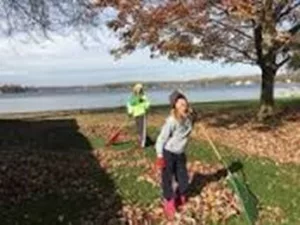On a recent trip to one of our Forest County Lakes, I noticed several homeowners blowing or raking leaves into the lakes. As leaves carpet lawns and sidewalks, many residents and property owners traditionally rake and dispose of them, often into nearby lakes. However, it’s time to reconsider this practice.
Nutrient Recycling
When leaves naturally fall into lakes, they don’t go to waste; instead, they serve as a valuable source of nutrients. Leaves are rich in carbon, which provides a vital energy source for aquatic microorganisms. These microorganisms, in turn, support the entire aquatic food web. When leaves decompose in the water, they release essential nutrients like phosphorus and nitrogen, which are critical for the growth of algae and aquatic plants. This natural recycling process enhances the overall health of the lake ecosystem, but raking leaves into a lake, accelerates this process and leads to an excess of nutrients which leads to excessive algae and weed growth.
Habitat Creation
Leaves submerged in the water create a diverse and dynamic habitat for aquatic organisms. Small invertebrates, fish, and amphibians find shelter among the leaf litter, using it as a nursery and feeding ground. The intricate structure of leaves also provides hiding spots for prey and helps predators hunt effectively. By not raking leaves into lakes, we are essentially preserving and enhancing the biodiversity of these aquatic environments. Again, too many leaves disrupt the natural biodiversity and cause problems for aquatic animals.
Water Quality Improvement
Leaves play a crucial role in maintaining water quality. When leaves enter the water, they absorb pollutants such as heavy metals and organic contaminants. This natural filtration process helps purify the water, making it healthier for both aquatic life and human use. In contrast, raking leaves into lakes can disrupt this cleansing mechanism, leading to poorer water quality over time.
Erosion Control
Leaves in and around lakes act as a buffer against erosion. They help stabilize the soil and prevent sediments from washing into the water, which can cloud it and harm aquatic organisms. Additionally, the root systems of trees and plants that shed leaves help bind the soil together, further reducing erosion risks. By leaving leaves in place, we contribute to the overall stability of our lake ecosystems.
Cost-Effective and Sustainable
Not raking leaves into Forest County lakes is not only ecologically beneficial but also cost-effective. Leaf removal can be an expensive and labor-intensive task. By allowing leaves that fall naturally into lakes to decompose, property owners can save time, money, and energy while supporting local ecosystems.
Community Involvement
Promoting the practice of not raking leaves into lakes can foster a sense of community involvement and environmental stewardship. Local organizations and communities can work together to educate residents about the ecological importance of this practice and encourage responsible leaf disposal methods.
In Forest County, the beauty of our natural surroundings is a source of pride and inspiration for all who call it home. By refraining from raking leaves into our lakes, we can take a simple yet significant step towards preserving and enhancing the health of these vital ecosystems. Nutrient recycling, habitat creation, improved water quality, erosion control, cost-effectiveness, and community involvement are compelling reasons to embrace this eco-friendly practice. So, this autumn, let’s choose to leave the leaves, ensuring a brighter and more sustainable future for Forest County’s lakes and the entire community.
Conservation Corner is a weekly article produced by the Forest County Land & Water Conservation Department. For more information contact Steve Kircher, County Conservationist-Land Information/GIS Director at 715-478-1387 or by e-mail at .
